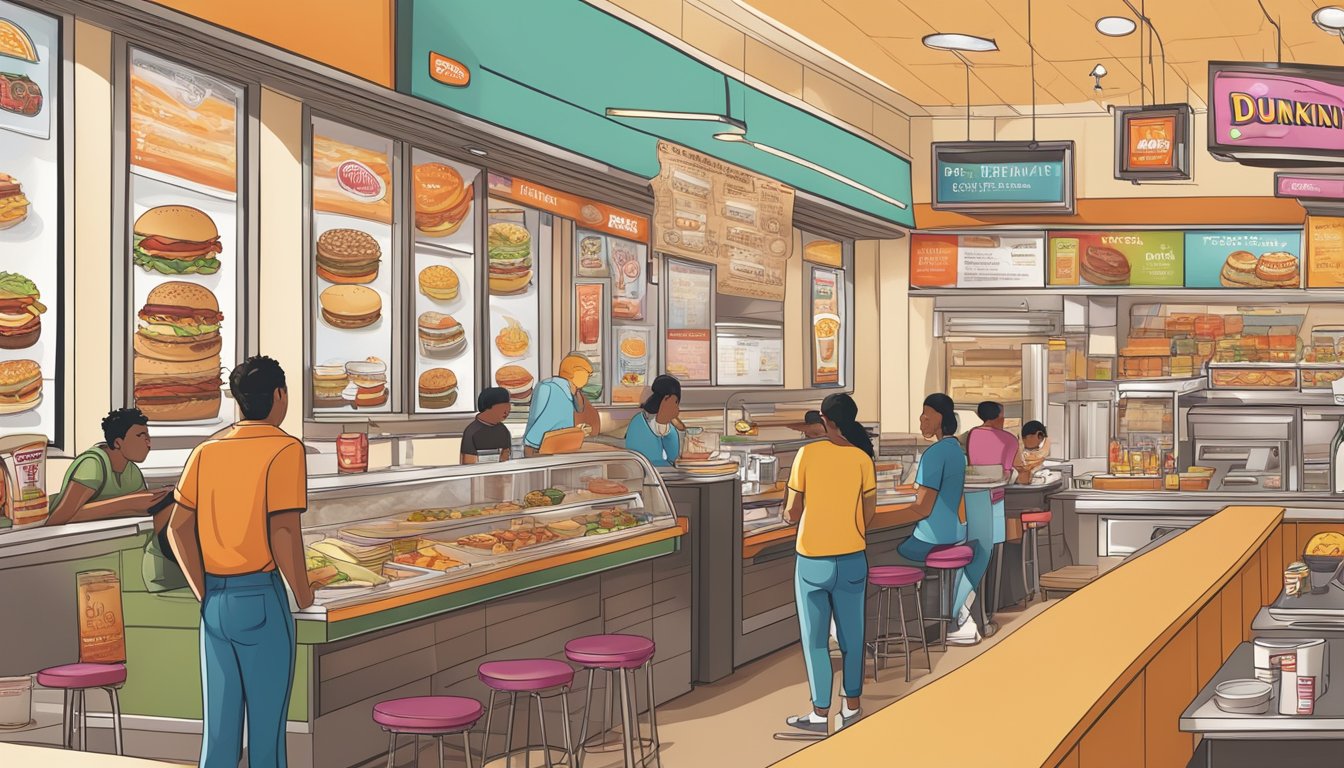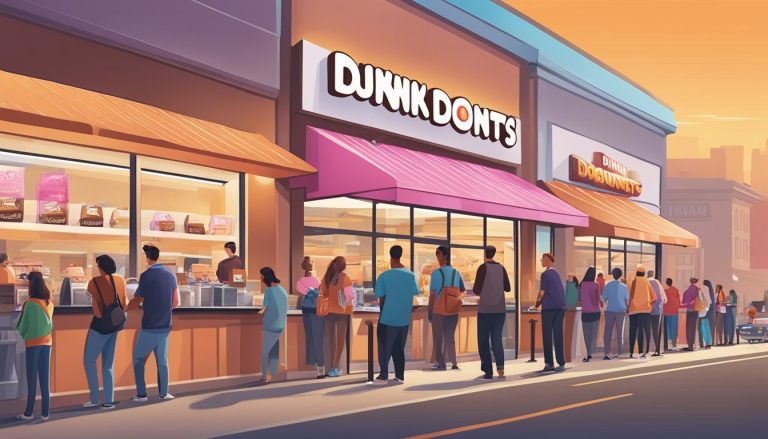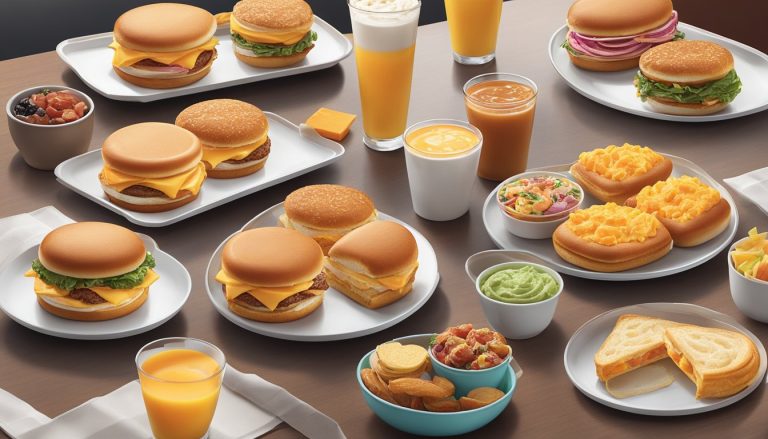Dunkin’ has become a major player in the fast food breakfast wars, challenging industry giants like McDonald’s with innovative menu offerings. The company’s strategic move to expand beyond its traditional coffee and donuts has reshaped the competitive landscape. Dunkin’s introduction of breakfast tacos in 2023 marked a significant shift in its approach to capturing market share in the morning meal segment.
This menu expansion reflects Dunkin’s commitment to diversifying its breakfast options and appealing to a broader customer base. By introducing items like breakfast tacos, ham and cheese roll-ups, and donut fries, Dunkin’ has positioned itself as a versatile breakfast destination. The company’s efforts to modernize its menu while maintaining its core identity have allowed it to compete more effectively with other fast food chains.
Dunkin’s influence on the fast food breakfast market extends beyond its menu innovations. The company has also focused on revamping its store layouts and drive-thru experiences to enhance customer convenience. These changes, combined with its expanded breakfast offerings, have strengthened Dunkin’s competitive advantage and cemented its position as a formidable contender in the fast food breakfast arena.
Historical Impact of Dunkin’ on Breakfast Menus

Dunkin’ has profoundly shaped the fast-food breakfast landscape since its inception. Its innovative approach to quick-service breakfast offerings revolutionized the industry and set new standards for convenience and variety.
The Rise of Dunkin’ Donuts
Dunkin’ Donuts began as a small coffee shop in Quincy, Massachusetts in 1950. William Rosenberg, the founder, recognized the growing demand for quick, affordable breakfast options. The company’s focus on coffee and donuts quickly gained popularity.
Dunkin’ introduced the concept of franchising to the coffee and donut industry in 1955. This strategy allowed for rapid expansion across America. By the 1960s, Dunkin’ had become a household name, with over 100 locations.
The slogan “America Runs on Dunkin'” was introduced in 2006, cementing the brand’s status as a breakfast staple. This catchphrase highlighted Dunkin’s role in fueling Americans’ mornings with coffee and baked goods.
Expansion of Breakfast Offerings
In the 1970s, Dunkin’ began diversifying its menu beyond coffee and donuts. The introduction of muffins and breakfast pastries marked the beginning of a broader breakfast selection.
Bagels joined the menu in 1996, catering to changing consumer preferences. This addition significantly expanded Dunkin’s appeal and market share in the breakfast segment.
The launch of breakfast sandwiches in 1997 was a game-changer. These portable, savory options complemented Dunkin’s sweet offerings and attracted a new customer base. The move positioned Dunkin’ as a serious contender in the fast-food breakfast market.
Influence on Fast-Food Breakfast Trends
Dunkin’s success prompted other fast-food chains to expand their breakfast menus. The company’s emphasis on coffee quality raised industry standards for morning beverages.
The introduction of all-day breakfast at Dunkin’ in 2003 set a new trend in the industry. This move challenged traditional meal time restrictions and influenced competitors to offer extended breakfast hours.
Dunkin’s menu innovations, such as breakfast wraps and bowls, inspired similar offerings across the fast-food sector. The company’s ability to blend traditional breakfast items with modern tastes has kept it at the forefront of breakfast trends.
Dunkin’s focus on customization, particularly in coffee orders, has become an industry standard. This approach has led to increased customer loyalty and set new expectations for personalized breakfast experiences in fast-food establishments.
Comparison with Major Competitors
Dunkin’ faces stiff competition in the fast-food breakfast market. Its rivals have adapted their menus and strategies in response to Dunkin’s popularity, leading to a dynamic landscape of breakfast offerings across major chains.
Menu Innovation Versus Starbucks
Dunkin’ and Starbucks engage in ongoing menu innovation to attract customers. Dunkin’ emphasizes its coffee and donut heritage while expanding into premium beverages. Starbucks counters with seasonal flavors and health-conscious options.
Dunkin’ offers a wider range of breakfast sandwiches, giving it an edge in the morning food category. Starbucks has responded by improving its food selection, but still lags behind in variety.
Both chains have introduced mobile ordering and loyalty programs. Dunkin’s program tends to focus on value, while Starbucks aims for a more premium experience.
Breakfast Offerings: McDonald’s and Burger King
McDonald’s remains a formidable competitor with its iconic Egg McMuffin. The chain has expanded its breakfast menu to include healthier options and all-day breakfast availability.
Burger King has revamped its morning offerings to compete more directly with Dunkin’. They’ve introduced new breakfast sandwiches and improved coffee quality.
Both chains leverage their drive-thru infrastructure for quick service, an area where Dunkin’ has had to catch up. McDonald’s and Burger King also benefit from lower price points on many breakfast items.
Fast-Food Breakfast Landscape: Taco Bell’s Response
Taco Bell entered the breakfast market in 2014, challenging traditional morning fare. Their menu features unique items like breakfast burritos and Crunchwraps, differentiating from Dunkin’s more conventional offerings.
This move forced Dunkin’ to innovate further, leading to the introduction of breakfast bowls and wraps. Taco Bell’s success has shown there’s room for diverse breakfast options beyond coffee and pastries.
Taco Bell’s breakfast menu has attracted younger consumers, prompting Dunkin’ to focus on appealing to this demographic through social media marketing and trendier menu items.
Dunkin’s Business Strategy
Dunkin’ has developed a robust business strategy focused on brand evolution, convenience, and global expansion through franchising. These key elements have positioned the company as a major player in the quick-service restaurant industry.
Brand Evolution and Market Positioning
Dunkin’ has strategically evolved its brand to appeal to a broader customer base. The company dropped “Donuts” from its name in 2019, emphasizing its expanded menu offerings beyond just doughnuts. This rebranding effort aimed to position Dunkin’ as a beverage-led, on-the-go brand.
The company has introduced healthier options and premium products to cater to changing consumer preferences. Dunkin’s market positioning focuses on providing affordable, high-quality coffee and food items in a fast-paced environment.
To stay competitive, Dunkin’ regularly updates its menu with seasonal offerings and limited-time promotions. This strategy keeps customers engaged and encourages repeat visits.
Focus on Convenience and Speed of Service
Dunkin’ prioritizes convenience and speed as core elements of its business model. The company has invested heavily in drive-thru services, with a significant portion of its locations featuring this option. This emphasis on drive-thru service caters to busy customers seeking quick, on-the-go options.
The Dunkin’ mobile app plays a crucial role in enhancing convenience. It allows customers to place orders in advance, make payments, and earn rewards. The app’s features streamline the ordering process and reduce wait times.
Dunkin’ has also implemented in-store technology upgrades to improve service speed. These include digital menu boards and advanced point-of-sale systems.
Franchise Model and Global Expansion
Dunkin’s franchise-based business model has been key to its rapid growth and global expansion. This approach allows the company to leverage local expertise while minimizing capital investment.
The franchise system provides Dunkin’ with a steady stream of royalty income and helps maintain consistent brand standards across locations. Franchisees benefit from Dunkin’s established brand recognition and operational support.
Dunkin’ has expanded its presence in international markets, adapting its menu and store designs to suit local tastes and preferences. This global strategy has helped the company enter new markets and diversify its revenue streams.
The company carefully selects franchise partners with local market knowledge and financial resources to ensure successful expansion in different regions.
Customer Experience and Loyalty
Dunkin’ has cultivated a dedicated following through strategic initiatives focused on customer satisfaction and retention. The company’s approach encompasses personalized rewards, innovative menu offerings, and digital engagement to keep patrons coming back.
Development of a Loyal Customer Base
Dunkin’ launched its DD Perks Rewards Program in 2014, marking a significant shift in customer engagement. This program allows customers to earn points on purchases, redeemable for free beverages. The tiered system encourages frequent visits and higher spending.
Dunkin’ also leverages data analytics to tailor offers to individual preferences. This personalization extends to email marketing and mobile notifications, creating a sense of value for each customer.
The brand’s commitment to quick service and consistent quality plays a crucial role in fostering loyalty. Dunkin’ has streamlined its operations to ensure speedy transactions, particularly in drive-thru locations.
Role of Specialty Drinks and Seasonal Menus
Dunkin’ regularly introduces specialty drinks and limited-time offers to generate excitement and drive repeat visits. These innovative beverages often align with holidays or seasons, creating a sense of urgency and exclusivity.
Popular items like the Pumpkin Spice Latte and holiday-themed donuts have become annual traditions for many customers. This anticipation builds brand affinity and encourages social media sharing.
The company also collaborates with other brands to create unique flavor combinations. These partnerships expand Dunkin’s appeal and attract new customer segments.
Impact of Mobile App Usage on Retention
Dunkin’s mobile app serves as a cornerstone of its digital strategy, significantly boosting customer retention. The app integrates the rewards program, mobile ordering, and payment options for a seamless experience.
Key features include:
- On-the-Go Mobile Ordering
- Store locator with real-time wait times
- Customizable favorite orders
- Digital gift cards
The app’s convenience has led to increased order frequency and higher average ticket sizes. Mobile users tend to be more loyal, with higher lifetime value compared to non-app customers.
Dunkin’ regularly updates the app with new features and promotions, ensuring continued engagement and relevance in the competitive fast-food landscape.
Innovation in Breakfast Menu Items
Fast food chains have introduced creative new offerings to capture the morning market. Breakfast menus now feature diverse options beyond traditional fare, with a focus on convenience and flavor.
Pastries and Croissants as Breakfast Staples
Dunkin’ led the way in elevating pastries from simple sides to main breakfast items. Croissants gained popularity as versatile bases for sandwiches and standalone treats. Chains now offer butter croissants, chocolate-filled varieties, and savory options stuffed with eggs and cheese.
Many restaurants expanded their pastry selections to include muffins, danishes, and coffee cakes. These items appeal to customers seeking a quick grab-and-go option or a sweet complement to their morning coffee.
Variety and Customization of Breakfast Sandwiches
Breakfast sandwiches evolved significantly, with chains offering diverse bread choices and fillings. English muffins, bagels, and biscuits became common alternatives to standard toast. Protein options expanded beyond bacon and sausage to include steak, ham, and plant-based alternatives.
Customization emerged as a key trend. Customers can now select their preferred combination of bread, protein, cheese, and toppings. This personalization caters to individual tastes and dietary needs.
Some chains introduced unique sandwich concepts like breakfast tacos or wraps to differentiate themselves in the competitive market.
Cold Beverages: Iced Coffee and Beyond
Iced coffee revolutionized morning drink options, with Dunkin’ playing a significant role in its popularity. Chains now offer various cold brew and iced latte flavors, often featuring seasonal specials.
The cold beverage trend extended to smoothies and frozen drinks. These options appeal to health-conscious consumers and those seeking refreshing alternatives to hot coffee.
Many restaurants also introduced specialty cold drinks like nitro cold brew or flavored iced teas to cater to evolving consumer preferences. These innovative beverages help chains stand out and attract younger customers looking for Instagram-worthy menu items.
Operational Excellence and Supply Chain
Dunkin’ has established itself as a leader in the fast food breakfast market through operational efficiency and supply chain innovation. The company’s focus on consistency and optimization has allowed it to maintain high quality standards while managing costs effectively.
Consistency in Food Quality and Service
Dunkin’ prioritizes uniform quality across its locations. The company implements standardized recipes, equipment, and training programs to ensure customers receive the same experience regardless of which store they visit. Franchise owners follow strict guidelines for food preparation and storage. Dunkin’ also emphasizes speed of service, with many locations featuring drive-thru windows and mobile ordering options.
Quality control measures include regular inspections and mystery shopper programs. These initiatives help maintain consistency in taste, appearance, and customer service. Dunkin’ continuously refines its menu offerings based on customer feedback and market trends.
Supply Chain Optimization
Dunkin’ has developed a robust supply chain network to support its extensive franchise operations. The company partners with approved suppliers to source ingredients and equipment. This centralized approach allows Dunkin’ to leverage economies of scale and maintain quality control.
Distribution centers are strategically located to efficiently serve regional markets. Dunkin’ utilizes advanced inventory management systems to track stock levels and predict demand. This helps reduce waste and ensures restaurants have fresh ingredients on hand.
The company has also invested in technology to streamline ordering and delivery processes. Franchisees can easily place orders through digital platforms, improving accuracy and reducing administrative workload. Dunkin’s supply chain innovations have helped it respond quickly to market changes and maintain competitive pricing.
The Future of Dunkin’ and the Breakfast Segment

Dunkin’ is poised to shape the fast-food breakfast landscape in the coming years. The company’s strategies and consumer trends will likely influence the entire segment.
Predictions on Evolving Consumer Preferences
Gen Z and Millennials are driving fast-food breakfast demand. This trend is expected to continue, with younger consumers seeking convenient, on-the-go options.
Healthier breakfast choices may gain traction. Dunkin’ could expand its menu to include more nutritious items, catering to health-conscious customers.
Customization will likely become more important. Consumers may expect personalized breakfast options, prompting Dunkin’ to offer more mix-and-match combinations.
Mobile ordering and delivery services will grow. Dunkin’ may invest further in its digital platforms to meet the rising demand for contactless and convenient ordering.
Potential Moves and Counter-Strategies
Dunkin’ might focus on expanding its drive-thru presence. The “Dunkin’ Drive-To” initiative could lead to more locations optimized for quick service.
Menu innovation will be crucial. Dunkin’ may introduce new breakfast sandwiches or reinvent classic items to maintain customer interest.
Sustainability efforts could increase. Dunkin’ might adopt eco-friendly packaging or sourcing practices to appeal to environmentally conscious consumers.
Competitors may respond by enhancing their breakfast offerings. This could lead to a more competitive breakfast segment, with chains vying for market share.
Partnerships with food delivery platforms may expand. Dunkin’ and its competitors might forge new alliances to reach customers who prefer at-home dining.




